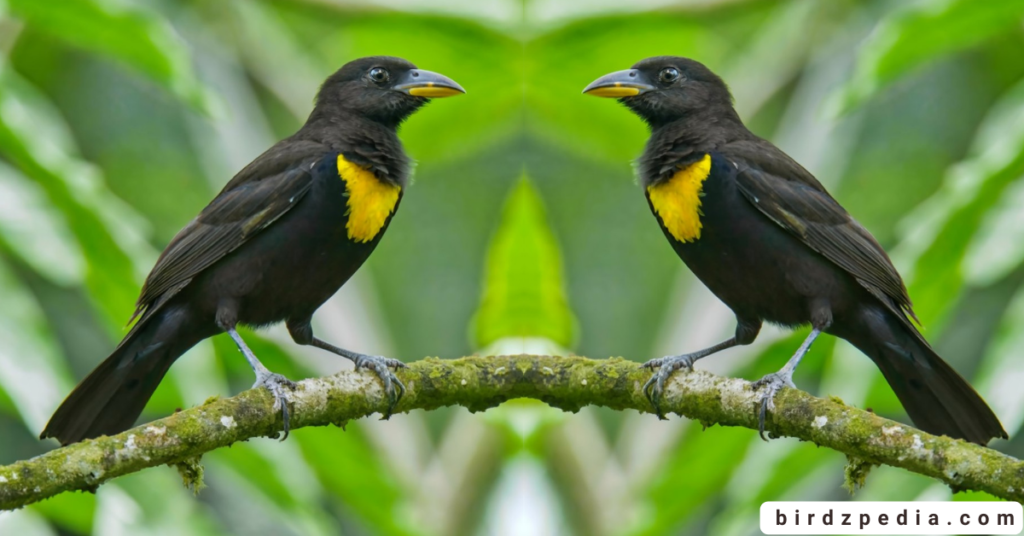Yellow-rumped Cacique [Cacicus cela] Guide Food, Habitat, Sound:
Scientific Classification
| Kingdom | Phylum | Class | Order | Family | Genus | Species |
|---|---|---|---|---|---|---|
| Animalia | Chordata | Aves | Passeriformes | Icteridae | Cacicus | cela |
Yellow-rumped Cacique
The yellow-rumped cacique (Cacicus cela), a passerine bird, belongs to the family Icteridae of birds found in the New World. Its breeding grounds span the entirety of northern South America, from central Brazil, Peru, and Bolivia in the south, to Panama and Trinidad in the north. Notably,
sightings have been reported all the way up to the northern province of Nayarit in Mexico.

Summary
- Family: Icteridae (New World blackbirds)
- Characteristics: Sleek black bird with blue eyes and distinctive yellow wings.
- Noteworthy: Sightings reported as far north as Mexico’s Nayarit state.
- Taxonomy:
- Scientific Name: Cacicus cela
- Passerine bird in the New World family Icteridae.
- Description:
- Sleek black bird with blue eyes.
- Distinctive yellow wings.
- Typically found in Brazilian rainforests.
- Distribution and Habitat:
- Breeds in northern South America.
- Range from Panama and Trinidad to Peru, Bolivia, and central Brazil.
- Habitat: Rainforests, particularly in Brazil.
- Behaviour and Ecology:
- Social species often found in colonies.
- Breeds in large groups with territorial males.
- Polygynous mating behavior.
- Breeding:
- Breeding range spans northern South America.
- Colonial nesting habits.
- Relationship with Humans:
- No significant negative interactions reported.
- An attractive and gregarious bird, providing ecological balance in its habitat
Taxonomy
Swedish naturalist Carl Linnaeus published the first official description of them in 1758. The species was given the binomial name Parus cela by Linnaeus in the eleventh edition of his Systema Naturae. Although the exact origin of the special epithet “cela” is
unknown, it is thought to be a contraction of the Ancient Greek word kelainos, which means “black.” But Linnaeus wrote Indiis (India) instead of Indiis (home). This mistake was corrected in 1906 by the Austrian naturalist Carl Eduard Hellmayr, who identified Suriname as the proper type
location. The yellow-rumped cacique is currently classified under the genus Cacique, which was first used by Bernard Germain de Lacépède in 1799.There are three recognized subspecies:North and central Colombia via the Panama Canal Zone (C. c. vitellinus Lawrence, 1864)C. flavicrissus
(Sclater, PL, 1860): northwest Peru and west Ecuad or East Colombia, Venezuela, the Guianas, south to middle Bolivia, and south Brazil are all home to C. c. cela (Linnaeus, 1758).It is hypothesized that the first two subspecies—known as the saffron-rumped cacique—may belong to a distinct species.
Description
The female Cacicus cela averages 23 centimeters (9.1 in) in length and roughly 60 grams (2.1 oz) in weight, whilst the male normally measures about 28 centimeters (11 in) in length and weighs about 104 grams (3.7 oz). The bird has a thin body, bright blue eyes, a long
tail, and a pointed bill that is pale yellow in color. Its vivid yellow wing “epaulets,” tail base, and lower belly embellish its primarily black plumage. The juvenile is easily identified by its dark eyes and brown bill base, which resemble those of the female. Compared to the male, the female
seems less lively. The man sings a mesmerizing melody of wheezes, giggles, fluttering tones, and sporadic mimicking. An busy colony’s cacophony of different calls can be heard for a significant distance.

Distribution and Habitat
Northern South America, from Trinidad and Panama in the north to Peru, Bolivia, and central Brazil in the south, is home to the Cacicus cela. It is frequently seen in Brazil’s rainforests, where it flourishes in the enormous tropical and subtropical woods with their
lush, forested surroundings. Usually found in highly forested areas, these birds are found under the canopy of trees. Foraging and nesting behaviors are most suited to the rainforest’s varied and dynamic habitats. The Neotropical region is richer because of documented observations of the yellow-rumped cacique in several of the countries that fall within its range.
Species in same Genus
| Species | Common Name |
|---|---|
| Cacicus chrysopterus | Golden-winged Cacique |
| Cacicus haemorrhous | Red-rumped Cacique |
| Cacicus melanicterus | Dusky-headed Cacique |
| Cacicus uropygialis | Scarlet-rumped Cacique |
| Cacicus solitarius | Solitary Cacique |
| Cacicus koepckeae | Koepcke’s Cacique |
| Cacicus cela occidentalis | Ecuadorian Cacique |
| Cacicus chrysonotus | Bolivian Cacique |
| Cacicus viridis | Green Cacique |
| Cacicus cela vitellinus | Northern Cacique |
Behaviour and ecology
Social behavior is demonstrated by the Cacicus cela, which establishes colonies in its natural habitat in northern South America, particularly in Brazil. These birds tend to nest in groups and engage in polygynous mating, especially in the treetop canopies of dense
rainforests. The male’s captivating song, a combination of mimicry and fluting notes, comes from active colonies and adds to the lively dynamics of the ecology in the Neotropical region .Large insects (including beetles, caterpillars, crickets, grasshoppers, and katydids),
spiders (like orb-weavers), nectar, and fruit (such figs and chupa-chupa) are among the foods consumed by this gregarious bird.
Breeding
- Colonial breeder with up to 100 bag-shaped nests in a tree, often alongside an active wasp nest.
- Females construct, incubate, and care for the young in nests measuring 30–45 cm, widening at the base, and suspended from branches.
- Intense competition among females for prime nesting sites near the protection of wasp nests.
- Typical clutch consists of two dark-blotched pale blue or white eggs.
- Incubation starts after laying the second egg, with hatching occurring after 13 or 14 days.
- Young birds fledge in 34 to 40 days, usually with only one per nest.

Threats
| Threat | Description |
|---|---|
| Habitat Loss | Forest clearance and ranching have led to more open habitats, impacting the bird’s natural environment. |
| Climate Change | Alterations in climate patterns may affect the bird’s preferred habitats, influencing nesting and foraging. |
| Human Activity | Human disturbance, including deforestation and habitat alteration, can disrupt breeding and foraging behaviors. |
| Nest Predation | Predators targeting nests pose a threat to eggs and chicks, impacting reproductive success. |
| Disease and Parasites | Susceptibility to diseases and parasites can affect the health and overall population of Cacicus cela |
Relationship with Humans
Currently categorized as not threatened by the IUCN, them thrives in increasingly exposed habitats brought about by forest removal and grazing. It is called “paucar” in Peruvian mythology, along with other caciques and oropendolas; it is also called “paucarcillo”
(“little paucar”). A Moyobamba folktale connects this species to the story of a gossiping young person, always dressed in black trousers and a yellow jacket, who was changed into a chattering, nomadic bird by a disguised fairy. The bird is thought to represent good news.

Common Names in Different Languages
| Language | Common Name |
|---|---|
| English | Yellow-rumped Cacique |
| Spanish | Cacique de Lomo Amarillo |
| Portuguese | Cacique-de-lombo-amarelo |
| French | Cassique à croupion jaune |
| German | Gelbsteißkassike |
| Italian | Cassico dal groppone giallo |
| Dutch | Geelstuitkassika |
| Russian | Жёлтоспинный касик |
| Chinese (Mandarin) | 黄腰卡西克 |
| Japanese | キバラカシクイタドリ |
| Arabic | الكاسيك الأصفر الظهر |
| Hindi | पीला पुर्जा कैसीक |
| Bengali | হলুদ পিঠের ক্যাসিক |
| Swahili | Kasisi wa Kibete Njano |
FAQs
- What is the scientific name of the Yellow-rumped Cacique?
- The scientific name is Cacicus cela.
- Where is the natural habitat of the Cacicus cela?
- In Central and South America, Cacicus cela. live in forested areas and tropical and subtropical woods.
- What is the distinctive feature of their?
- In stark contrast to the rest of their black plumage, these birds are distinguished by their bright yellow rump. They are also medium-sized with a gently curved bill.
- What is the size of the Cacicus cela.?
- The length of their is between 25 to 33 cm (10 to 13 inches).
- What is the diet of their?
- Their food consists of fruits, insects, and small vertebrates, making them omnivores.
- Are they migratory birds?
- Though not all Cacicus cela. move, some populations may exhibit variable behavior.
- Do they nest in colonies?
- Yes, it is known that these caciques build their nests in colonies, and that they frequently weave their nests and hang them from tree branches.
- Are Cacicus cela. considered social birds?
- Indeed, especially in the breeding season, they wander in groups and are gregarious birds.
- What are the threats to them?
- Threats include possible predation and interference during nesting, as well as habitat degradation from deforestation.
- Are they protected by conservation efforts?
- Though there are regional differences in conservation efforts, certain areas have taken steps to preserve the habitats of Cacicus cela.


![Pelagic cormorant: [Urile pelagicus] Odyssey Habitat, and Overview](https://birdzpedia.com/wp-content/uploads/2024/01/Channel-Billed-Toucan-1-768x402.png)
![Black Skimmer [Rynchops niger], Diet, Predators, and Characteristics](https://birdzpedia.com/wp-content/uploads/2023/12/Black-Skimmer-768x402.png)
![Embracing Wildlife keel-billed Toucan:[Ramphastos sulfuratus]](https://birdzpedia.com/wp-content/uploads/2024/01/Keel-Billed-Toucan-768x402.png)
![Fish Crow [Corvus ossifragus] Facts, Sounds, Habitat](https://birdzpedia.com/wp-content/uploads/2023/12/Fish-Crow-768x402.png)

![Discovering The Indian cormorant[Phalacrocorax fuscicollis]](https://birdzpedia.com/wp-content/uploads/2024/01/Indian-cormorant-768x402.jpg)